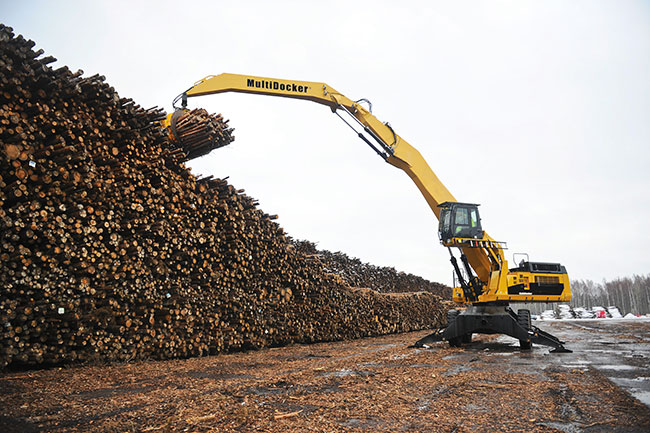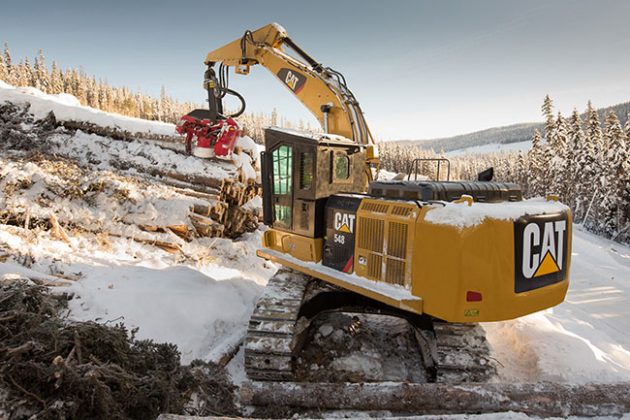
Features
Machinery
Before you buy: how an equipment maintenance strategy can boost productivity
September 30, 2020 By Brian Mulvihill
 A MultiDocker hydraulic material handler for the forestry, scrap recycling and bulk handling industry. The base of their machines are produced by Caterpillar and many of the parts are standard Cat components. Photos courtesy Finning Canada.
A MultiDocker hydraulic material handler for the forestry, scrap recycling and bulk handling industry. The base of their machines are produced by Caterpillar and many of the parts are standard Cat components. Photos courtesy Finning Canada.
Keeping equipment running is critical to an efficient operation. Getting the most out of your machine starts the moment it leaves the dealership and enters your fleet. Incorporating a maintenance plan and strategy from the point of purchase will increase productivity and lower costs, and help extend the life of the machine.
From the beginning
All equipment will eventually reach the end of its life cycle and a logger must decide to either repair, rebuild or replace the machine at some point. There are many factors to consider – the costs of owning, operating, and maintenance will affect the total life cycle of the machine but future depreciation, resale value and production levels also need to be considered. The end goal is always to get the best return on your investment. Having a concrete business strategy that considers all factors can help bring clarity to the situation and, in particular, having a strategy from the start can keep costs down and your equipment running.
Rebuilding or repairing equipment can be more economical than purchasing new, but the best way to get the full picture is by doing a cost analysis. One way to do this is to use a Life Cycle Profitability (LCP) calculator, which can help you decide on the best option for your business. Your LCP plan should start the day you buy the machine and you should discuss with your dealer at the time of purchase what options are available to you. Things can and will change, but a flexible plan and having a strategy in place from the beginning can provide a long-term roadmap to success for your business.
Maintenance – a big factor
Unscheduled repairs and unplanned downtime are often the culprits getting in the way of machines meeting production goals. That’s why the best equipment plans involve discipline and following a scheduled maintenance program to give your machine the care and attention it needs to decrease downtime and meet productivity goals for the life of the machine.
Regularly scheduled maintenance combined with just-in-time service can also extend operating hours. Done right, you can stretch that initial 10,000-hour milestone to 12,000 hours or more before you need to consider a trade-in.
Recognizing important maintenance milestones, including switching out minor components before they fail, will help to ensure machines can deliver their maximum value and peak operating hours. An unplanned failure can cost three to four times that of a planned component change-out. And this doesn’t account for the added issues associated with lack of productivity. The availability of parts and service for unscheduled maintenance can also significantly impact the cost and timing for repairs and further extend machine downtime.
Consider all options
Once you understand what your business priorities are and you’ve conducted a cost analysis, you should also look at the advantages and disadvantages of repairing, rebuilding or replacing your equipment, as well as when it makes the most sense to do so.
The primary goal for repairs is to keep equipment components intact so the machine can continue to function and accumulate hours. This can be the quickest and most affordable way to get a machine back up and running and typically does not require a visit to the repair shop. However, repairs can sometimes fall short if you want to get the best life expectancy out of a machine or access the latest technology.
If you are considering a rebuild, the turnaround is typically six to eight weeks. But if not properly planned, the time frame can increase significantly and go on for months. A basic rebuild involves replacing parts, changing out components, calibration and adjustments, with the end result being a like-new machine that should perform at the same level as a brand new one. A good rebuild should be well organized, ensuring all the necessary parts are ordered in advance of the job start date and giving time to schedule technicians for the repair, go over the rebuild plan in detail and understand the owners’ expectations and business needs. The right equipment dealer can guarantee exchange components down the line, including the availability of not just parts, but service and labour.
Some contractors will trade in their equipment for a new or used machine. But if the data has not been captured on the machine from the beginning, they can risk trading it in too early, resulting in an unnecessary loss in life cycle productivity. In a recent survey of western Canadian dealers on used processor inventory, machines that were 10 years old or newer had an average of 11,000 hours or less – meaning customers were trading in machines well before the end of their functional life and were not getting the most value out of the machine.

The Cat 548 Forest Machine. Purpose built for high production work, the 548 optimizes engine, hydraulics, technology and controls delivering peak efficiency and productivity.
Use your dealer
Engaging your dealer at the time of purchase can significantly increase productivity and help reduce downtime due to equipment failure. Dealers can also help track maintenance schedules and machine health to ensure service and repairs are done before they become a bigger issue to both your business and the bottom-line.
Tapping into a dealer’s network of service and support options can take your business to the next level of productivity. Experienced dealers are equipped to help with parts and maintenance programs such as remote monitoring, which provides a unified view of the health, location and productivity of your entire fleet. They can also provide a better understanding of other technologies like GPS and telematics to bring new insights into job site operations, streamline communication, increase efficiency and keep workers safe on site.
Dealers can also help in the collection and analysis of data and offer continued support when it comes to monitoring machine health and tracking maintenance and service requirements to maximize uptime. When a machine is monitored by the dealer, they will know when maintenance is required to avoid a failure, what parts are needed for the job and they will be able to order the parts when needed. This can help prevent ordering and shipping delays and minimize the time the machine is out of service.
Most dealers can also arrange financing and have product support representatives available to address your equipment questions and concerns.
Stay competitive
Forestry operations will stay productive and efficient when loggers invest in quality equipment, leverage new technologies and partner with a trusted, informed dealer. Working with a dealer on a future plan, using the tools available, and sticking to a maintenance strategy will help stretch the life of equipment and provide substantial cost savings in the long run.
New technologies may come along, workloads may fluctuate, and the industry may experience more ups and downs, but a strong maintenance strategy and a better understanding of equipment needs and available options provide the best opportunity for loggers to get the most out of their fleet.
Brian Mulvihill is the industry manager – forestry for Finning Canada.
Print this page